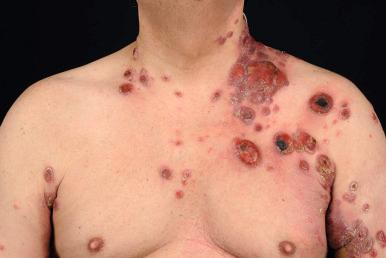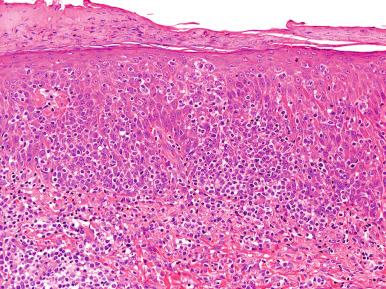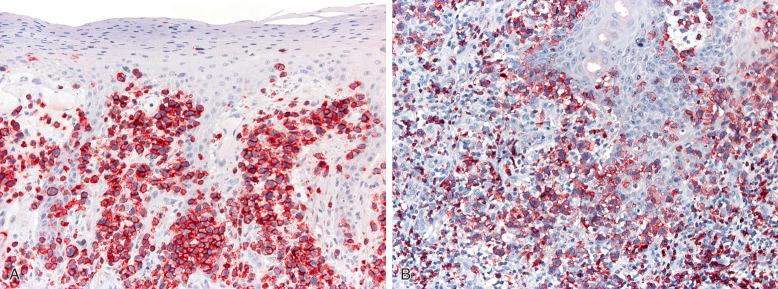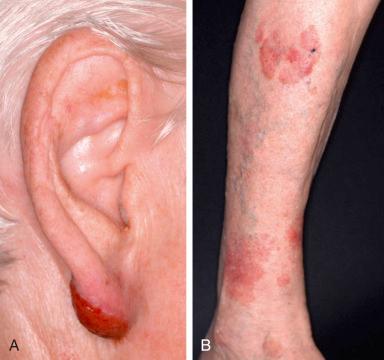Physical Address
304 North Cardinal St.
Dorchester Center, MA 02124
Cutaneous T-cell lymphomas (CTCLs) comprise, for the most part, mycosis fungoides (MF) and variants and cutaneous CD30 + lymphoproliferative disorders, but other rare subtypes may be the source of diagnostic and therapeutic challenges. Some of these rare lymphomas show overlapping clinicopathologic features, and distinction from MF may be difficult or even impossible without proper history and complete clinical information. In spite of extensive phenotypic and genotypic studies, a few cases may defy precise classification. In this context, some considerations are necessary.
Epidermotropism is not diagnostic of any type of cutaneous lymphoma. It can be encountered in different variants of CTCL and rarely in cutaneous B-cell lymphomas as well. Prominent epidermotropism of single lymphocytes (pagetoid epidermotropism), on the other hand, is usually observed in some cases of MF (pagetoid reticulosis, cytotoxic variants of MF) and in cutaneous aggressive cytotoxic NK/T-cell lymphomas (primary cutaneous γδ T-cell lymphoma [pcγδTCL], cutaneous aggressive epidermotropic CD8 + cytotoxic T-cell lymphoma, and cutaneous extranodal NK/T-cell lymphoma, nasal-type [cENKTCL-NT]).
Prominent involvement of the subcutaneous fat with “rimming” of adipocytes is not synonymous with subcutaneous panniculitis-like T-cell lymphoma (SPTCL). It is a typical feature of other types of CTCL as well (particularly pcγδTCL and cENKTCL-NT).
Although association with Epstein-Barr virus (EBV) is typical of cENKTCL-NT, it can be observed rarely also in other types of CTCL. It is diagnostic of cENKTCL-NT only if other clinicopathologic features are compelling, too.
A cytotoxic phenotype characterizes a group of aggressive CTCLs, but the presence of neoplastic cytotoxic cells can be observed in virtually all subtypes of CTCL; thus, it does not represent a diagnostic (or prognostic) feature. Histopathologic differential diagnostic features of cutaneous NK/T-cell lymphomas with cytotoxic phenotype are summarized in Table 41-1 .
| pcγδTCL | cENKTCL-NT | pcAECD8CTCL | SPTCL | MF-C | LyP-D | cALCL | cPTCL-NOS | pcACD8TCL | |
| Pagetoid epidermotropism | +/− | − (+) | + | − | + | + | − (+) | − | − |
| Subcutaneous panniculitis-like pattern | + | + | − | + | − | − | − | − | − |
| CD4 | − | − | − | − | − | − | − | + | − |
| CD8 | −/+ | − | + | + | + | + | +/− | −/+ | + |
| CD30 | − | − | − | − | − | + | + | − | − |
| EBV | − (+) | + | − | − (+) | − | − | − | − | − |
| αβ phenotype | − | −/+ | + | + | + | + | + | + | + |
| γδ phenotype | + | (+) | − | − | − (+) | − (+) | − | − | − |
| TCR-R monoclonal | + | −/+ | + | + | + | + | + | + | + |
Cytomorphologic features of neoplastic cells in most of these rare subtypes of CTCL are variable and are not associated with the clinical outcome (i.e., small or large cell variants of a given entity have the same behavior). Moreover, neoplastic cells in all of these entities share similar cytomorphologic aspects (characterized by predominance of either small, medium-sized, or large cells, usually with pleomorphic nuclei). Thus, cytomorphologic features are useful neither for a specific diagnosis and classification nor for assessment of the prognosis.
This is a cutaneous lymphoma composed of CD8 + cytotoxic T lymphocytes, characterized morphologically by prominent epidermotropism and clinically by an aggressive clinical course. In the past, this lymphoma was classified as either aggressive MF (MF tumeur d'emblée) or generalized pagetoid reticulosis (Ketron-Goodman type).
The tumor occurs in adults of both sexes with a slight male predominance. Only one case has been reported in children.
The etiology is not known.
Patients have localized or more frequently generalized patches, plaques, and tumors, almost invariably ulcerated ( Fig. 41-1 ). Involvement of the mucosal regions is common. Before a case is classified as primary cutaneous aggressive epidermotropic CD8 + cytotoxic T-cell lymphoma, it is crucial to exclude a diagnosis of MF or of lymphomatoid papulosis.

Histology reveals a plaquelike, nodular or diffuse proliferation of lymphocytes with marked epidermotropism ( Fig. 41-2 ). Although prominent epidermotropism may confer a so-called pagetoid appearance to the infiltrate, it may be less pronounced or even missing in some lesions, particularly in advanced stages; thus, lack of epidermotropic lymphocytes is not sufficient to rule out this entity. Spongiosis and intraepidermal or subepidermal vesiculation may be observed. Invasion and destruction of adnexal skin structures are common, but angiocentricity and angiodestruction are infrequent. Cytomorphology is variable and can be characterized by small, medium-sized, or large pleomorphic cells.

Immunohistology reveals a characteristic phenotypic profile of neoplastic lymphocytes (βF1 + , TCRγ − , CD2 −/+ , CD3 + , CD4 − , CD5 −/+ , CD7 + , CD8 + , TIA-1 + , granzyme B + , CD30 − , CD45Ra + , CD45RO − , CD56 − ; Fig. 41-3 ), but pan–T-cell markers may be lost. The EBV is not detectable in neoplastic cells.

Molecular biology shows a monoclonal rearrangement of the T-cell receptor (TCR) genes. Array comparative genomic hybridization investigations showed that gains (particularly in chromosomes 3, 7, 8, 11, 17, 18, and 22) are more frequent than losses (found frequently at 9p21, suggesting a role of p16).
Primary cutaneous aggressive epidermotropic CD8 + cytotoxic T-cell lymphoma has a poor prognosis with an estimated 5-year survival of 0%. The disease often metastasizes to the lung, testis, and central nervous system.
Distinction from cases of CD8 + MF and from lymphomatoid papulosis type D is made mainly on the basis of the clinical presentation and behavior. In contrast to MF, patients with primary cutaneous aggressive epidermotropic CD8 + cytotoxic T-cell lymphoma present from the beginning with generalized plaques and tumors. Lymphomatoid papulosis type D is characterized by the typical “waxing and waning” of papules and small nodules.
Pediatric patients with a clinical presentation resembling hydroa vacciniforme and association with EBV should be better classified as hydroa vacciniforme–like T-cell lymphoma. Cases of CD8 + T-cell lymphoma with exclusive involvement of the subcutis should be classified as SPTCL. Distinction of primary cutaneous aggressive epidermotropic CD8 + cytotoxic T-cell lymphoma from cutaneous γδ T-cell lymphoma is achieved mainly by demonstration of expression of αβ and negativity for γδ. Primary cutaneous acral CD8 + T-cell lymphoma is characterized by dermal infiltrates devoid of epidermotropism histopathologically and usually by solitary, non-ulcerated lesions (mostly on the ear and face) clinically.
Primary cutaneous γδ T-cell lymphoma (pcγδTCL) is a tumor of cytotoxic γδ T lymphocytes with specific tropism for the skin. This lymphoma shows overlapping features with other CTCLs, particularly MF, SPTCL, and primary cutaneous aggressive epidermotropic CD8 + cytotoxic T-cell lymphoma. Cases of pcγδTCL in the past have been classified as aggressive MF (MF tumeur d'emblée), generalized pagetoid reticulosis (Ketron-Goodman type), or subcutaneous T-cell lymphoma.
It is crucial to remember that a γδ phenotype is not unique to pcγδTCL. It can be observed in several cutaneous (and extracutaneous) lymphoma types, including MF.
pcγδTCL occurs in adults, with an equal distribution between men and women. Cases in children have been reported.
Etiologic factors are not known.
Patients have localized or generalized patches, plaques, and tumors, often ulcerated, and the clinical features may be indistinguishable from those of advanced MF ( Fig. 41-4 ). In some patients, lesions are restricted to the lower extremities. Subcutaneous tumors may also be seen. Involvement of the mucosal regions is common. Lactate dehydrogenase is elevated in the majority of patients, whereas bone marrow involvement is uncommon. A hemophagocytic syndrome is a frequent complication. Almost one fourth of the patients had an associated autoimmune disorder in one study, and onset of pcγδTCL has been observed also during treatment with etanercept for rheumatoid arthritis.

Besides cutaneous and hepatosplenic cases, γδ T-cell lymphomas can be observed also at other nodal or extranodal sites, thus underlying the need for staging investigations.
Become a Clinical Tree membership for Full access and enjoy Unlimited articles
If you are a member. Log in here